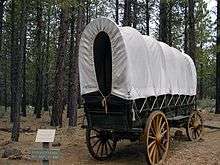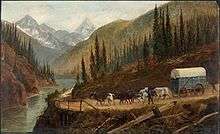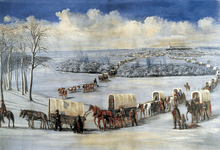Covered wagon

The covered wagon was long the dominant form of transport in pre-industrial America. With roots in the heavy Conestoga wagon developed for the rough, undeveloped roads and paths of the colonial East, the covered wagon spread west with American migration. Heavily relied upon along such travel routes as the Great Wagon Road and the Santa Fe and Oregon Trails, it carried settlers seeking land, gold, and new futures ever further west.
With its ubiquitous exposure in 20th century media, the covered wagon grew to become an icon of the American West. The fanciful nickname Prairie Schooner and romantic depiction in wagon trains only served to embellish the legend.
History


In Colonial times the Conestoga wagon[1] was popular for migration southward through the Great Appalachian Valley along the Great Wagon Road. After the American Revolution it was used to open up commerce to Pittsburgh and Ohio. The Conestoga, often in long wagon trains, was the primary overland cargo vehicle over the Appalachian Mountains until the development of the railroad. The wagon was pulled by a team of up to eight horses or up to a dozen oxen. For this purpose, the Conestoga horse, a special breed of medium to heavy draft horses, was developed.
Once breached, the moderate terrain and fertile land between the Appalachians and the Mississippi was rapidly settled. In the mid-nineteenth century thousands of Americans took a wide variety of farm wagons[2] across the Great Plains from developed parts of the Midwest to places in the West such as California, Oregon, Colorado, and Montana. Overland migrants typically fitted any sturdy wagon with five or six wooden or metal bows that arched high over the bed. Over this was stretched canvas or similar sturdy cloth, creating the distinctive covered wagon silhouette.
Covered wagons were primarily used to transport cargo, as well as small children, elderly, and the infirm. Lacking suspensions, their rides were rough even over good ground, all but unbearable over rough. Those who could, walked.
While covered wagons traveling short distances on good roads could be drawn by horses, those crossing the plains were usually pulled by a team of two or more pairs of oxen. These were driven by a teamster or drover, who walked at the left side of the team and directed the oxen with verbal commands and whipcracks. Mules were also used, harnessed and controlled from the wagon with reins.
One covered wagon generally carried the belongings of five people. A well-to-do family might have two or three, or a group of single men traveling together might share one. While crossing the plains, emigrants banded together to form wagon trains for mutual assistance and occasionally defense (the latter purpose and associated formation giving rise to the still-used idiom "circle [or 'circled' or 'circling'] the wagons").
Because the wagon bed is narrow, many families would construct an “overjet” for additional space. An overjet is created by nailing boards or planks on top of the wagon bed that extend out over the wheels. This would create space to place mattresses for sleeping on either sides of the bed. Additional bows would be inserted to stretch the canvas to cover the overjet and keep the weather out. The area under the planks in the wagon bed could be used for storage. Homesteading prairie families would use the wagons as temporary accommodations until they could build more permanent housing.
Prairie schooner is a fanciful name for the covered wagon drawing on their broad white canvas covers, romantically envisioned as the sails of a ship crossing the sea.[3]
See also
References
- ↑ "Wayne Works". CoachBuilt. Retrieved December 8, 2013.
- ↑ Stewart, George R. (1962). "The Prairie Schooner Got Them There". American Heritage Magazine. 13 (2).
- ↑ The Prairie Schooner Got Them There, American Heritage Magazine
External links
![]()